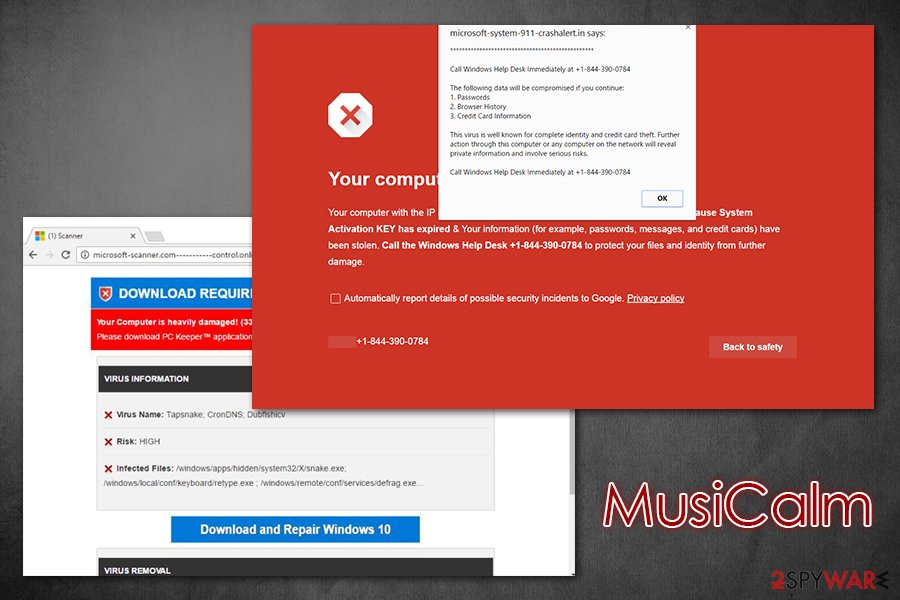MusiCalm (Removal Instructions) - Virus Removal Guide
MusiCalm Removal Guide
What is MusiCalm?
MusiCalm – a music player that will flood your browsers with ads

MusiCalm is a potentially unwanted program that users typically download in a bundle from third-party sites. As a result, they do not notice the entry point, so many even aren't aware that they have the program installed in the first place. What is depicted as a useful media player is actually an intrusive adware application that will display pop-ups, deals, offers, coupons, and another type of advertisement on Google Chrome, Mozilla Firefox, MS Edge, Safari, or another web browser.
Additionally, users might hind that their web browser settings, such as the new tab URL, homepage, and the search engine, were altered by the MusiCalm virus. Besides the intrusive commercial content, adware is also often used to track users' web browsing activities and, in some cases, even record personal information like email for marketing purposes. If you want to get rid of MusiCalm ads, you have to uninstall the app from your system.
| Name | MusiCalm |
| Type | Adware, potentially unwanted program |
| Alleged functionality | Music player |
| Infiltration | Pirated software installers, software cracks, freeware bundles, fake updates, and other shady methods |
| Symptoms | Intrusive advertisements show up on all websites that you visit, web browser settings altered, unknown browser extensions or apps installed without permissions, redirects bring to insecure sites, etc. |
| Risks | Installation of other potentially unwanted programs or malware, loss of personal information, financial losses, identity theft |
| Executable names | SmoothVideo Project (SVP) Pro 4.3.0.182 Crack Registration Key [Latest].exe, MusiCalm.exe, Setup_Video_Codecs.exe |
| Removal | If you found the app on your system unexpectedly or you downloaded a software crack, you should immediately scan the machine with anti-malware software. Nonetheless, you can also eliminate the PUP manually in most cases – we provide full instructions below |
| System fix | Malware can sometimes damage system files, making the computer crash, lag, or suffer from other stability issues |
While most users download MusiCalm adware from legitimate third-party software distribution sites, some versions of the virus were also observed being spread via illegal cracking tool installers, such as SmoothVideo Project (SVP) Pro 4.3.0.182 Crack Registration Key [Latest].exe. Downloading software cracks is a huge security risk, and you should not engage in such activities in order to avoid the MusiCalm virus, as well as much more devastating computer infections such as ransomware or remote access trojan (RAT).[1]
Also, there are several reputable anti-malware programs that could prevent the infiltration of MusiCalm and other infections. One of the application samples is recognized as follows on Virus Total:[2]
- Win32:AdwareSig [Adw]
- Gen:Variant.MSILPerseus.213713
- Generic PUA NO (PUA)
- Trojan:MSIL/Skeeyah!MTB
- Trojan.Gen.MBT
- Artemis!PUP
- Trojan.Win32.Generic.pak!cobra
Judging by the definitions of anti-malware detection, some versions of the MusiCalm virus can be classified as Trojans. Such infections are particularly dangerous, as they operate silently in the background, and are typically performing data-harvesting operations. As a result, users might get their sensitive information compromised, such as credit card details or social security numbers.
If you have been infected with a similar malware, you should hurry MusiCalm removal, as otherwise, you might suffer from financial losses or even identity theft. For that, you should use reputable anti-malware software such as SpyHunter 5Combo Cleaner or Malwarebytes – download the latest version and initiate a full system scan. This will remove MusiCalm and all its components from your machine in just a few minutes.
Unfortunately, those who download MusiCalm and are unaware of its presence might only notice the symptoms of infection when bowing the web. As previously mentioned, several browser settings might be altered without permission, and users might see changes within search results already – they might be littered with ads and sponsored links.
While most of these links are relatively safe, some MusiCalm ads and redirects can bring users to far more nefarious places on the internet. Those infected with adware are prone to be redirected to tech support scams, spoofing, fake update, or similar malicious websites. It is important not to download and install anything at this point, as the computer might suffer from further infections. Additionally, the infected users might also notice ads marked as “Ads by MusiCalm,” “Powered by MusiCalm,” or similar.

Thus, MusiCalm virus infection will not only serve intrusive ads during your web browsing sessions, alter search results, and otherwise disturb online activities, but might also compromise your security. Get rid of the threat, reset all the web browsers, and then scan the machine with anti-malware and computer repair software like FortectIntego for best results.
Note: there is another application for iOS devices that is also called MusiCalm. However, please take note that it is not the same as MusiCalm adware, and the former is legitimate and safe, developed by Improve Yazılım Hizmetleri Sanayi ve Ticaret Limited Şirketi (can be downloaded from the official Apple's App Store).
Be careful when you download and install new apps to avoid unwanted software
While adware is generally considered more of a nuisance than a security threat, some potentially unwanted programs are borderline malware and should be looked at seriously. Since most of the PUPs are delivered via deceptive methods, users might not even be aware that their computers and personal safety are exposed to risks. On the other hand, many adware apps that require installation can be eliminated easily manually; in other cases, browser extensions can also make browsers show ads and expose them to unneeded risks, although they can be eliminated very easily.
Since there are thousands of apps created regularly, it is difficult to track which ones are secure and which are not – especially from regular users. The best way to get around this is to ensure that PUPs are not installed on the computer in the first place – and it is relatively easy to do. Here's what experts from lesvirus.fr[3] advise:
- If possible, always download applications from official sources, such as Google Web Store, Microsoft Store, etc.;
- If you choose to download programs from third-parties, always opt for Advanced/Custom settings when prompted;
- Read the fine print, as it can provide important information about the installation;
- Watch out for misleading deals/offers and misplaced buttons during the installation process;
- Remove all ticks next to add-ons, media players, PDF converters, system optimizers, and other offered software;
- Employ anti-malware software that can detect PUPs.
Eliminate MusiCalm from your system
MusiCalm removal highly depends on your system configuration, installed apps, and many other features. Since rogue apps are often delivered in bundles, it is highly likely that, in case your device was infected with one of such unwanted programs, there are more. If you simply notice an increased amount of advertisements and web browser changes, you can try to remove MusiCalm manually by following the detailed guide below and resetting all the installed browsers.

Nonetheless, the MusiCalm virus might not be the only infection on your system, so the best way to handle this is to perform a full system scan with reputable anti-malware software that can recognize potentially unwanted programs. Besides, if you downloaded software cracks or similar illegal tools, your system might be infected with trojans, data-stealers, crypto-miners, and other malicious software. Security programs can check your system thoroughly and eliminate all the found malicious components. Besides, anti-malware can also keep you safe from future adware/malware infections as long as you keep it up to date.
You may remove virus damage with a help of FortectIntego. SpyHunter 5Combo Cleaner and Malwarebytes are recommended to detect potentially unwanted programs and viruses with all their files and registry entries that are related to them.
Getting rid of MusiCalm. Follow these steps
Uninstall from Windows
Top get rid of MusiCalm via Control Panel, follow these steps:
Instructions for Windows 10/8 machines:
- Enter Control Panel into Windows search box and hit Enter or click on the search result.
- Under Programs, select Uninstall a program.

- From the list, find the entry of the suspicious program.
- Right-click on the application and select Uninstall.
- If User Account Control shows up, click Yes.
- Wait till uninstallation process is complete and click OK.

If you are Windows 7/XP user, proceed with the following instructions:
- Click on Windows Start > Control Panel located on the right pane (if you are Windows XP user, click on Add/Remove Programs).
- In Control Panel, select Programs > Uninstall a program.

- Pick the unwanted application by clicking on it once.
- At the top, click Uninstall/Change.
- In the confirmation prompt, pick Yes.
- Click OK once the removal process is finished.
Delete from macOS
Remove items from Applications folder:
- From the menu bar, select Go > Applications.
- In the Applications folder, look for all related entries.
- Click on the app and drag it to Trash (or right-click and pick Move to Trash)

To fully remove an unwanted app, you need to access Application Support, LaunchAgents, and LaunchDaemons folders and delete relevant files:
- Select Go > Go to Folder.
- Enter /Library/Application Support and click Go or press Enter.
- In the Application Support folder, look for any dubious entries and then delete them.
- Now enter /Library/LaunchAgents and /Library/LaunchDaemons folders the same way and terminate all the related .plist files.

Remove from Microsoft Edge
Delete unwanted extensions from MS Edge:
- Select Menu (three horizontal dots at the top-right of the browser window) and pick Extensions.
- From the list, pick the extension and click on the Gear icon.
- Click on Uninstall at the bottom.

Clear cookies and other browser data:
- Click on the Menu (three horizontal dots at the top-right of the browser window) and select Privacy & security.
- Under Clear browsing data, pick Choose what to clear.
- Select everything (apart from passwords, although you might want to include Media licenses as well, if applicable) and click on Clear.

Restore new tab and homepage settings:
- Click the menu icon and choose Settings.
- Then find On startup section.
- Click Disable if you found any suspicious domain.
Reset MS Edge if the above steps did not work:
- Press on Ctrl + Shift + Esc to open Task Manager.
- Click on More details arrow at the bottom of the window.
- Select Details tab.
- Now scroll down and locate every entry with Microsoft Edge name in it. Right-click on each of them and select End Task to stop MS Edge from running.

If this solution failed to help you, you need to use an advanced Edge reset method. Note that you need to backup your data before proceeding.
- Find the following folder on your computer: C:\\Users\\%username%\\AppData\\Local\\Packages\\Microsoft.MicrosoftEdge_8wekyb3d8bbwe.
- Press Ctrl + A on your keyboard to select all folders.
- Right-click on them and pick Delete

- Now right-click on the Start button and pick Windows PowerShell (Admin).
- When the new window opens, copy and paste the following command, and then press Enter:
Get-AppXPackage -AllUsers -Name Microsoft.MicrosoftEdge | Foreach {Add-AppxPackage -DisableDevelopmentMode -Register “$($_.InstallLocation)\\AppXManifest.xml” -Verbose

Instructions for Chromium-based Edge
Delete extensions from MS Edge (Chromium):
- Open Edge and click select Settings > Extensions.
- Delete unwanted extensions by clicking Remove.

Clear cache and site data:
- Click on Menu and go to Settings.
- Select Privacy, search and services.
- Under Clear browsing data, pick Choose what to clear.
- Under Time range, pick All time.
- Select Clear now.

Reset Chromium-based MS Edge:
- Click on Menu and select Settings.
- On the left side, pick Reset settings.
- Select Restore settings to their default values.
- Confirm with Reset.

Remove from Mozilla Firefox (FF)
Remove dangerous extensions:
- Open Mozilla Firefox browser and click on the Menu (three horizontal lines at the top-right of the window).
- Select Add-ons.
- In here, select unwanted plugin and click Remove.

Reset the homepage:
- Click three horizontal lines at the top right corner to open the menu.
- Choose Options.
- Under Home options, enter your preferred site that will open every time you newly open the Mozilla Firefox.
Clear cookies and site data:
- Click Menu and pick Settings.
- Go to Privacy & Security section.
- Scroll down to locate Cookies and Site Data.
- Click on Clear Data…
- Select Cookies and Site Data, as well as Cached Web Content and press Clear.

Reset Mozilla Firefox
If clearing the browser as explained above did not help, reset Mozilla Firefox:
- Open Mozilla Firefox browser and click the Menu.
- Go to Help and then choose Troubleshooting Information.

- Under Give Firefox a tune up section, click on Refresh Firefox…
- Once the pop-up shows up, confirm the action by pressing on Refresh Firefox.

Remove from Google Chrome
Reset Google Chrome to eliminate settings that were set by the PUP:
Delete malicious extensions from Google Chrome:
- Open Google Chrome, click on the Menu (three vertical dots at the top-right corner) and select More tools > Extensions.
- In the newly opened window, you will see all the installed extensions. Uninstall all the suspicious plugins that might be related to the unwanted program by clicking Remove.

Clear cache and web data from Chrome:
- Click on Menu and pick Settings.
- Under Privacy and security, select Clear browsing data.
- Select Browsing history, Cookies and other site data, as well as Cached images and files.
- Click Clear data.

Change your homepage:
- Click menu and choose Settings.
- Look for a suspicious site in the On startup section.
- Click on Open a specific or set of pages and click on three dots to find the Remove option.
Reset Google Chrome:
If the previous methods did not help you, reset Google Chrome to eliminate all the unwanted components:
- Click on Menu and select Settings.
- In the Settings, scroll down and click Advanced.
- Scroll down and locate Reset and clean up section.
- Now click Restore settings to their original defaults.
- Confirm with Reset settings.

Delete from Safari
Remove unwanted extensions from Safari:
- Click Safari > Preferences…
- In the new window, pick Extensions.
- Select the unwanted extension and select Uninstall.

Clear cookies and other website data from Safari:
- Click Safari > Clear History…
- From the drop-down menu under Clear, pick all history.
- Confirm with Clear History.

Reset Safari if the above-mentioned steps did not help you:
- Click Safari > Preferences…
- Go to Advanced tab.
- Tick the Show Develop menu in menu bar.
- From the menu bar, click Develop, and then select Empty Caches.

After uninstalling this potentially unwanted program (PUP) and fixing each of your web browsers, we recommend you to scan your PC system with a reputable anti-spyware. This will help you to get rid of MusiCalm registry traces and will also identify related parasites or possible malware infections on your computer. For that you can use our top-rated malware remover: FortectIntego, SpyHunter 5Combo Cleaner or Malwarebytes.
How to prevent from getting adware
Choose a proper web browser and improve your safety with a VPN tool
Online spying has got momentum in recent years and people are getting more and more interested in how to protect their privacy online. One of the basic means to add a layer of security – choose the most private and secure web browser. Although web browsers can't grant full privacy protection and security, some of them are much better at sandboxing, HTTPS upgrading, active content blocking, tracking blocking, phishing protection, and similar privacy-oriented features. However, if you want true anonymity, we suggest you employ a powerful Private Internet Access VPN – it can encrypt all the traffic that comes and goes out of your computer, preventing tracking completely.
Lost your files? Use data recovery software
While some files located on any computer are replaceable or useless, others can be extremely valuable. Family photos, work documents, school projects – these are types of files that we don't want to lose. Unfortunately, there are many ways how unexpected data loss can occur: power cuts, Blue Screen of Death errors, hardware failures, crypto-malware attack, or even accidental deletion.
To ensure that all the files remain intact, you should prepare regular data backups. You can choose cloud-based or physical copies you could restore from later in case of a disaster. If your backups were lost as well or you never bothered to prepare any, Data Recovery Pro can be your only hope to retrieve your invaluable files.
- ^ Andrew Heinzman. What is RATMalware, and Why Is It So Dangerous?. How-To Geek. Site that explains technology.
- ^ 73edf63760603270ab67613d7f369139c592be857128c9f2779aa79a029209fd. Virus Total. File and URL analysis.
- ^ Lesvirus. Lesvirus. Malware news and cybersecurity advice.























